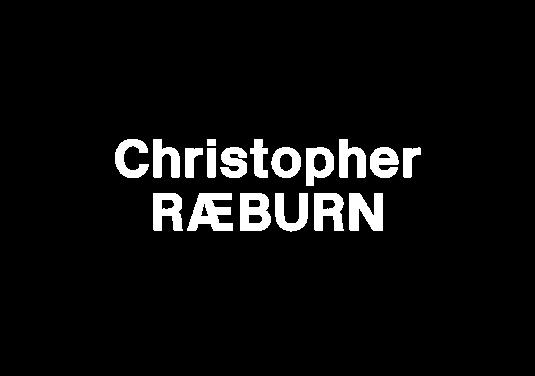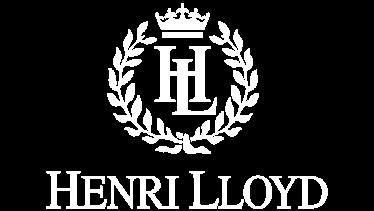Exploring how we as brand builders can evolve our thinking to positively impact the industries we love.
The Fashion Focus
STRATEGIC BRANDING FOR LEISURE & LIFESTYLE

Exploring how we as brand builders can evolve our thinking to positively impact the industries we love.
STRATEGIC BRANDING FOR LEISURE & LIFESTYLE

Fashion has played a big role in shaping my creative approach and, subsequently, that of Land of Plenty. It was what I studied and it’s an industry I’ve worked closely with throughout my career to date. It’s been ever-present.
But right now, it seems tougher than ever, with increasing pressure to get things right. Seen by some as a disposable commodity that only serves itself, it comes packaged with implications of newness, transience, and surface-level thinking.
That’s not to say brands can't do more to help the situation. Last March, the EU published the Greenwashing Claims Directive after the European Commissioner for the Environment found that over half of the environmental claims seen on labels and marketing were vague, misleading and unfounded. There's clearly room for improvement.
It’s so important, though, that we also find a positive space to champion brands doing their best to get it right so that we can see both where change needs to happen and where those little wins are – even if they’re just the start.
And look, we get it… we’ve worked with clients who are naturally nervous to talk about doing something small. Shying away from why they made their packaging biodegradable because the impact of their main product line is so big. Cautious to talk to their consumers about their values because they’re not even two seasons in. But relenting fear and guilt doesn’t get anyone anywhere.
It’s why at Land of Plenty, we’re led by joy and curiosity – and if you’re trying something new, big or small, we implore you to make it real. Because we know there’s so much support to be found when people share their stories.
So that’s what you’ll find over the next few pages. Shifts in fashion that are inspiring us to be better and the brands finding novel ways to get there.
We hope that all comes through in this edit. Helping you feel a little more inspired, and perhaps a little braver to create your own shift.
We’d love to hear what resonates with you.
Cheers, Jonny
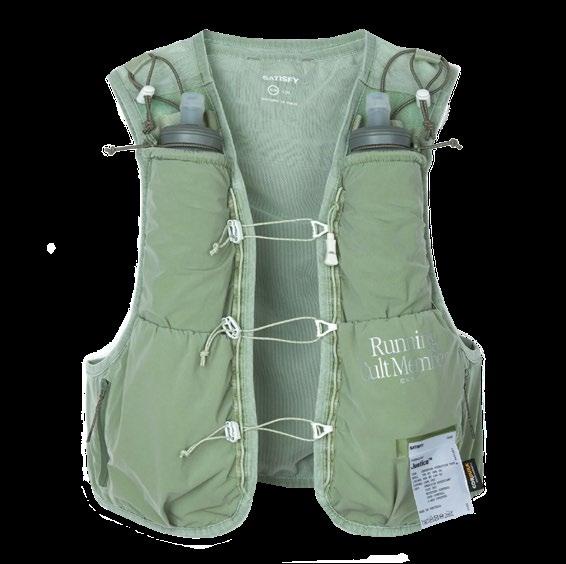

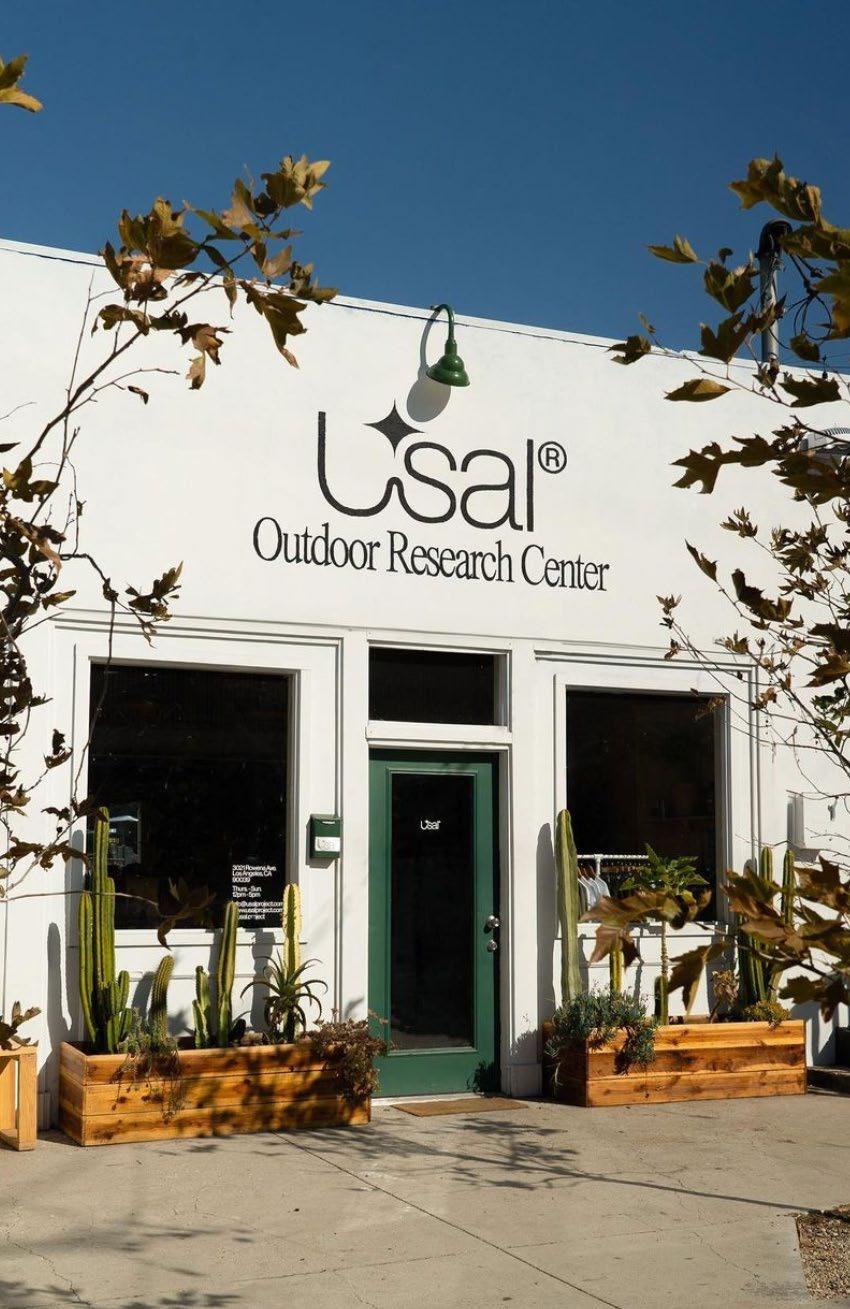



INTRODUCTION
Fashion START AT THE FUTURE Insights
Fashion Shifts
MARGINAL GAINS
1%ers
On A Roll
DIAL UP THE JOY
Dial Down the Guilt
Close-Knit Community
We've Got a Lot in Store for You
Talk the Walk
MAKING SHIFT HAPPEN
The Shift combines ideas, inspiration and insight that are helping us to build brands the planet loves.
If you’re reading to understand the intricacies of sustainable material design or get 10 quick steps to build your fashion empire, you’re probably on the wrong runway. But if you're here to better understand the challenges fashion brands are facing, and how they can begin to address them, well, welcome :)

What you get
64 pages of ideas, insights and inspiration on how to change the narrative on fashion
3 pages of exercises and tasks to help you start putting this thinking into practice
6 articles that are showing us new ways of being in the fashion industry
18 tangible ideas on how to connect style and substance in a future first economy
Before we start, let’s get one thing straight: we’re never going to proclaim we have all the answers. We’re not Miranda Priestly. We do, however, have a fresh take, and we’re going to bring that to life with some curious examples that we hope start a conversation with the kind of people we want to work with. And we’re hoping that’s you.
THE FACTS AND INSIGHTS
DIRECTING THE FUTURE WE'RE DESIGNING
“
Look, let’s get it out of the way. Fashion is among the most unsustainable industries on the planet, responsible for around 3 percent to 5 percent of global carbon emissions.”
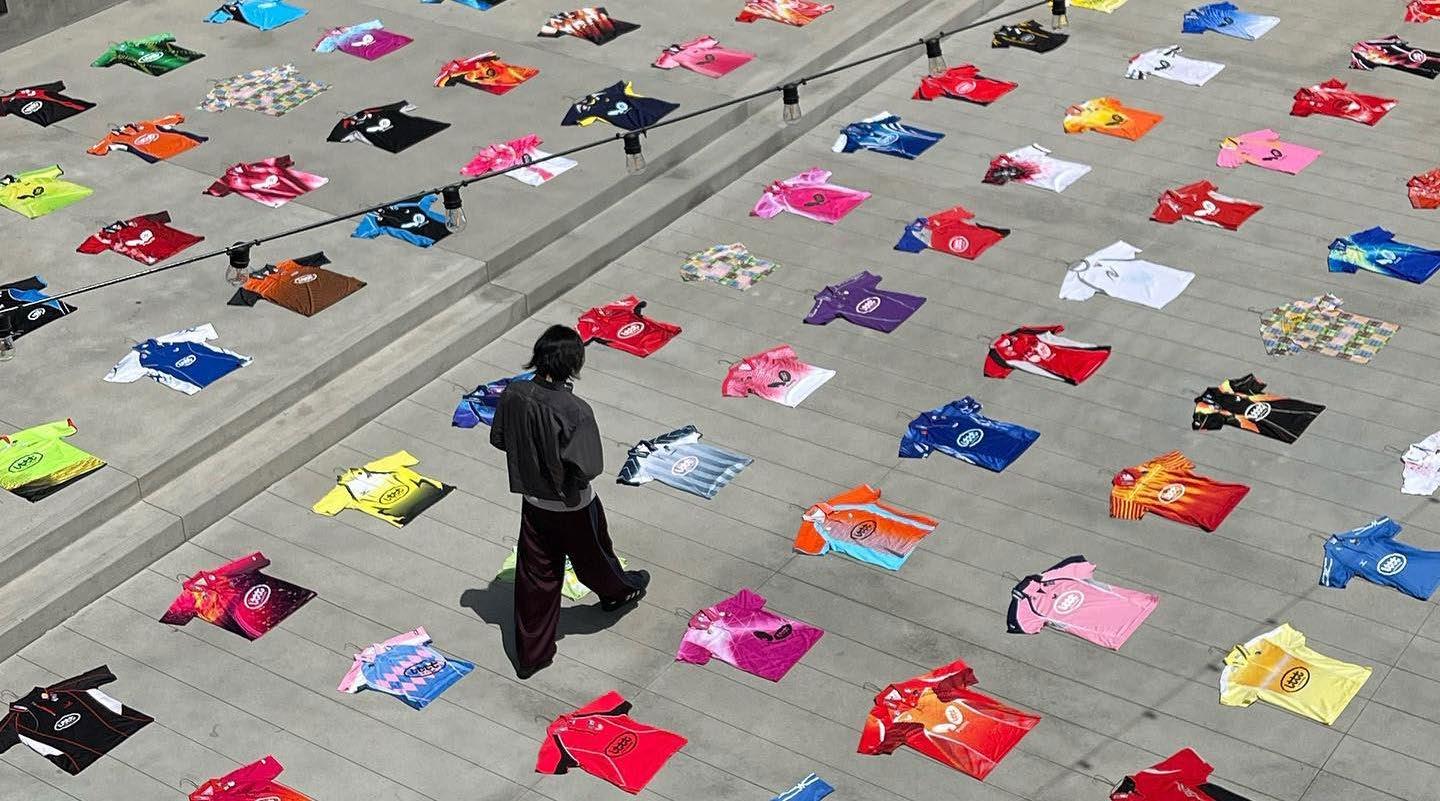
Almost a quarter of the big fashion brands have no decarbonisation plans, according to a Fashion Revolution report, including Reebok and Tom Ford.
It begs some big questions:
-Howquicklycanrealsustainablechangebemade?
-Whoisoperatinginawaythatwillreversedecades ofwaste?
-Whatarefashionbusinesseslearning?
-Whatpracticesaretheyadopting?
There's no doubt that Fashion is attracting a fair amount of criticism about its value to society. But people do still want to dress in a way that’s meaningful — or helpful — to them. They’d just rather do it without partaking in a wasteful, consumerist system.
Because done right, fashion is unrivalled at allowing us to celebrate identity. To make a statement. The clothes on our backs don’t just protect us from the elements, they convey meaning and beauty even when the world is on fire. Whether it’s the slogan tee that denounces Trump, your mum’s neverfails, hand-me-down party dress or the jeans that have gone 9 months without a wash, our fashion choices don’t half reflect our life choices.
And, to reiterate, the world really is on fire. According to the UNHCR, at least 89.3m people worldwide were forcibly displaced by the end of 2021. How are fashion's major players connecting to what's going on? Some UK brands – including Marks & Spencer and ASOS – have pledged to create jobs for Ukrainian refugees for example, whilst many others are failing to connect to shifts happening around them. Perhaps there are ways for fashion to step it up.
Throw in nationalised global depressions, a deepening cost of living crisis and landlocked oil, and finding new models of sharing, reworking and reimagining clothing are becoming more essential by the minute.

of Britons see sustainability as important for fashion. Sustainability has risen in importance in 2024, following a drop in interest in 2023 as incomes were squeezed.
The industry remains steadfastly linear — billions of pieces of clothing are simply discarded when unsold or at the end of their useful lives, ending up in landfill or incinerators.
There are enough material scientists, garment designers, and trend analysts frantically studying how we can reduce our impact.
But, as a design agency, we see a clear role to tell stories that will help consumers make the right choices when the right stuff does become available. Bracken shorts are one thing. The branding that implores you to purchase them is another.
Taking our three guiding principles, this report brings together those that are already challenging, imagining and trying to tell their tale a little better.
First, we’ll START AT THE FUTURE 01. 02. 03.
We all know we're only travelling in one direction. It's our job to get in front to see what's next. We’re sharing the shifts that will get us there — that will influence the DNA and storytelling of fashion’s future.
Small steps lead to big places. It's the 1%er mindset. We’ve selected the brands that are already chipping away to create the change we want to see, making progress in an industry that has an uphill battle.
Life’s too short to let the darkness define us. So we’ll share ideas that put a smile on our face, give us hope and encourage us to continue to collaborate with the fashion innovators.
We all know we're only travelling in one direction. It's our job to get in front to see what's next.
We’re sharing the shifts that will get us there — that will influence the DNA and storytelling of fashion’s future. We’ve brought together market insight that is shaping fashion customers’ relationships with clothes, as well as two future directions that challenge our perception of what
the best in fashion looks like.
We’ve looked at what’s out there, to inform where brands could go.

A lack of transparency from brands is making it difficult to track how the fashion industry is performing against its climate goals”
of people are willing to spend 45% 50% more on sustainable options.
− 33SECONDS.CO
of people feel overwhelmed by advertisements. To stand out requires more imagination than ever.
of females aged 16-24 value sustainability when purchasing, yet 54% of them buy from Shein.
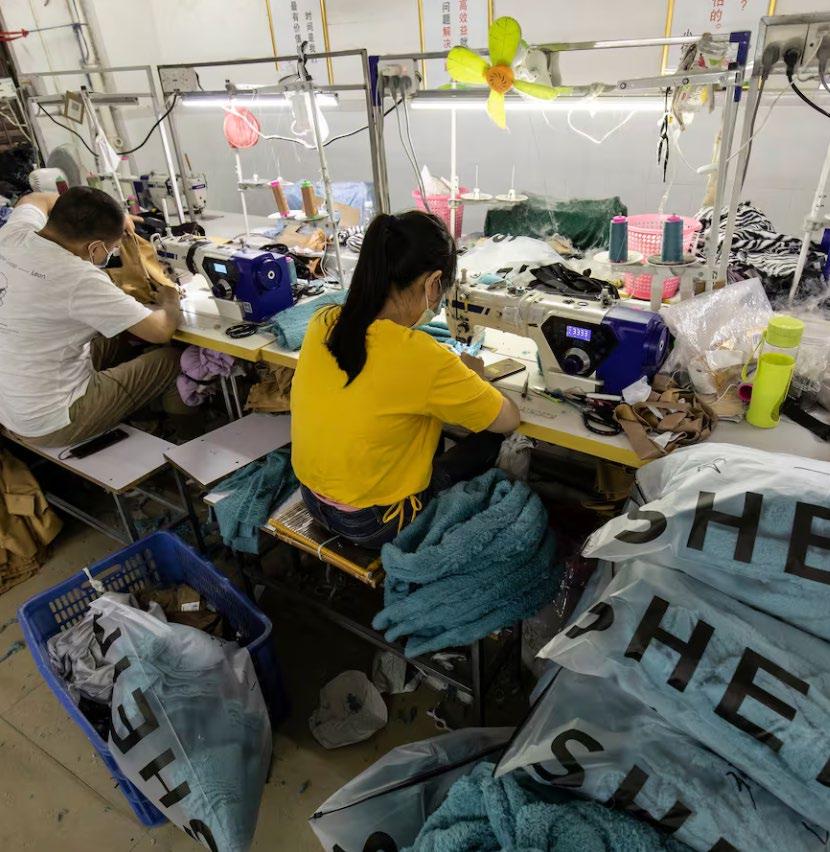
“
It’s not about marketing; it’s about explaining .... We need to work on simplifying it and making sure people can be part of the conversation.
With the younger generation, they don’t have the knowledge, so how do we engage, or how do we bring their expectations and how do we connect with them in simple ways? It’s not easy”
There’s a clear gap between people’s idealistic values and what they eventually stick in their basket.
− ANNE-LAURE DESCOURS, CHIEF SOURCING OFFICER, PUMA
How can we nudge them towards where they want to be? The options are there, businesses just need to work out which brand touchpoints are onto a winner.
According to our data, personality stands apart as the most sought after means of expression from fashion shoppers across the world”
The future is going to be about doing away with generic portrayals of consumers that obscure reality. We connect brands to people through their passions — the things they are fans of — and we can see that a revolution is taking place in fans’ relationships with sport and entertainment. There is a demand from fans to take ownership and reinvent the traditional relationship between them and their passions. Communities of fans are coalescing around nuanced elements of their passions, from football to film to fashion.” “
In October 2023, Loewe featured octogenarian British actress Maggie Smith — celebrating age, the reception was unanimously positive.
The minute a brand becomes formulaic, the clock starts ticking”
− JONATHAN ANDERSON, CREATIVE DIRECTOR, LOEWE

of global shoppers say they’re spending more time researching their purchases due to WFH, while... say they have discovered new brands and retailers as a consequence.
− WUNDERMANTHOMPSON
Consumers are still drawn to products. But the product alone is not enough. They want something that further enhances the experience, and connects to something bigger...
What can brands attach to their ranges to engage, educate or even enamour their fans?
Whilst online purchases dominate, fashion retail spaces are changing to become spaces for hosting, to serve communities and to create meaning around product.
Leases in shopping centres and high streets in the UK have declined between 20 percent and 30 percent compared to 2019. But brands exploring brick-andmortar may find that rents are more favourable in many key urban markets than they were before the pandemic.”
“64% of female fashion consumers have purchased items in-store over the last 12 months.”

The perception that men don’t like to shop for clothes is misguided. A majority of men think it’s fun to shop for clothes, and are more likely than women to be purposeful about their shopping conquests and seek out direct means to find what they want in the most efficient way.”
−
Whilst online purchases dominate, fashion retail spaces are adapting to become spaces for hosting, to serve communities and to create meaning around product — even for men.
How can businesses use this advantage to upsell their brand? Even creating new partnerships outside of their lane?
Working backwards from where we can go, to identify opportunities for positive change.
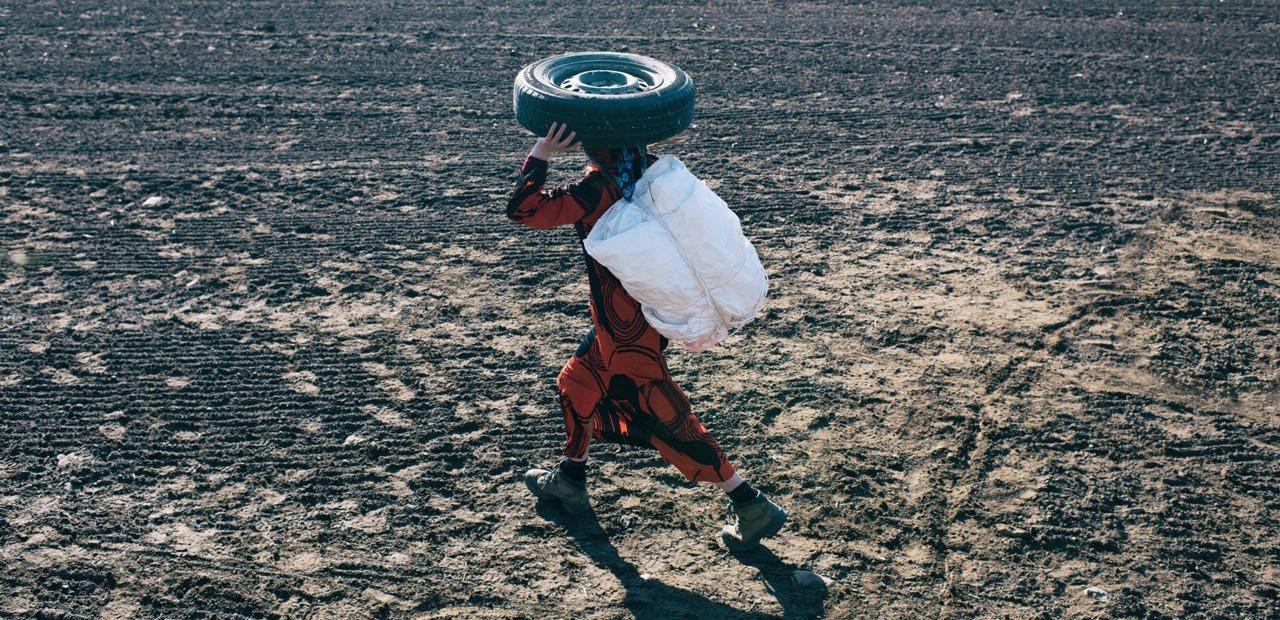
What will happen when we no longer privilege boxfresh?
If they’re going to reduce waste, at some point, consumers will have to bury the desire for the new, the clean, the straight out of the packet.

Resale and rental is on the up. Hypebae's Shakaila Forbes-Bell — a fashion psychologist and the best-selling author of Big Dress Energy — believes most people resort to fast fashion because of the pressure to wear new outfits at social occasions.
But a lot of us are waking up to this:
25%
“ of Americans say recommerce has become a trusted secondary source of income over the past 12 months.
Chances are that you already own it, but you’re letting yourself be swayed by the ideology that new equals better. Instead, think about how you want to look, how you want to feel and what energy you want to give off and shop your wardrobe.”
127%
$3.9B growth is expected in the resale market by 2026, according to ThredUp. is the estimated market value of fashion rental. Expected to double by 2025.
Pristine has no way back. We know resale is growing. Yet, perhaps a deeper shift is upon us — creating actual desire for imperfection through stories which reframe what we perceive as ‘good’. Fashion built to last will gather moss, wear its use and celebrate the dirty, mucky reality of being used. Really used.



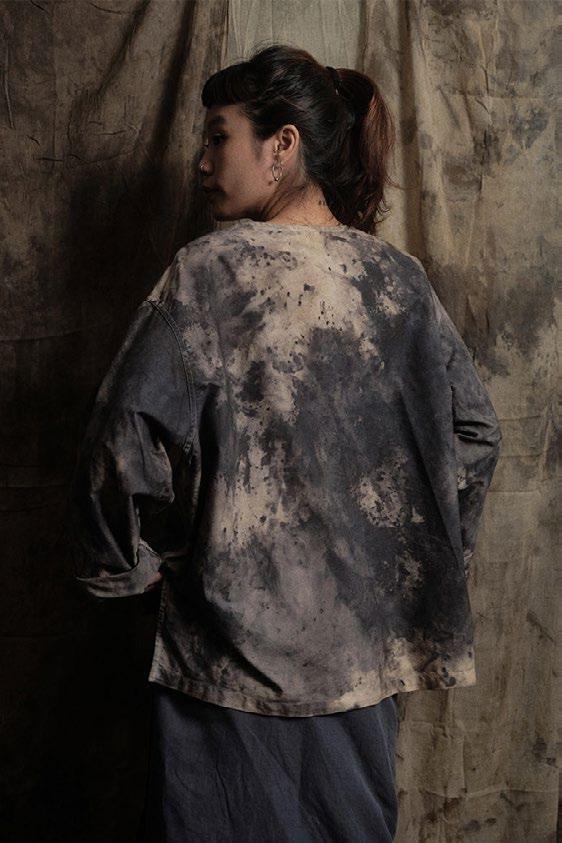
10 WEARS
Acne’s SS24 womenswear collection firmly steps into the noughties distressed look. With super-baggy denim and frayed leather, these lessthan-perfect looks make the sloppy, well… a whole lot less sloppy.
Jeans brands have long sold their wares on how good they’ll look the more they’re worn in. And while brands like Hiut Denim offer after-sales services and repairs for life, more companies are promoting age as a thing of beauty.
30 WEARS
Take Tefkit , who wear, wear and tear as a badge of honour. A ‘scar’ anyone who pursues a hobby can proudly display to show they got stuck in.
50 WEARS
Then there’s The Sabah Dealer
Epitomising the steps its shoes take with the line “El Paso Baba’s wear in, not out”, it showcases the natural evolution of materials offering a remedy to a newness addiction.
100 wears
Similarly Norda Run let their shoes capture the story, heroing happy customers and worn-in shoes that have gone the distance. Including one 65-year-old Italian’s magnificently topless 2500km journey.
150 WEARS
There’s nothing worse than getting a stain on something new. Unless it was stained to begin with. Project Coal ’s focus on natural dyes and botanical extracts creates a level of unpredictability and nuance in every finish. And, its re-dyeing service means that your favourite garments can get another lease of life..
When we dress for the challenges we face, do we become more imaginative meeting them?
When the world is in crisis, fashion responds. Often long before wider culture chimes in. But does being one step ahead further detach brands from our everyday lives?

Dystopia is shaping trends. You don’t need research to tell you consumers are making the link between climate change and extreme weather — but we’ve got some if you do.
Alongside this, we’ve seen a shift from hike-ready gorp-core to apocalypseready outerwear. And, as more people escape into the metaverse, cyber streetwear and digitally crafted design has also uploaded its way into normal society. In 2023, Pinterest found that Gen Z and Millennials were opting for futuristic fits, in response to the polycrisis around them.
Dystopian outfits are up: Avant garde garms are up: Gamer girl chic has rocketed:
Gearing up for changes in our future — be it to become part of the Solar Movement or to redefine athleisure for Blade Runner fanatics — our clothes are reflecting the vision we foresee.
And, with it, brands have an opportunity to tailor and connect their products to this climate-ready shift, whether adapting to the demands of our unrelenting weather shifts or getting ready for a new normal that integrates humans and nature harmoniously. ↑215% ↑225% ↑3370%

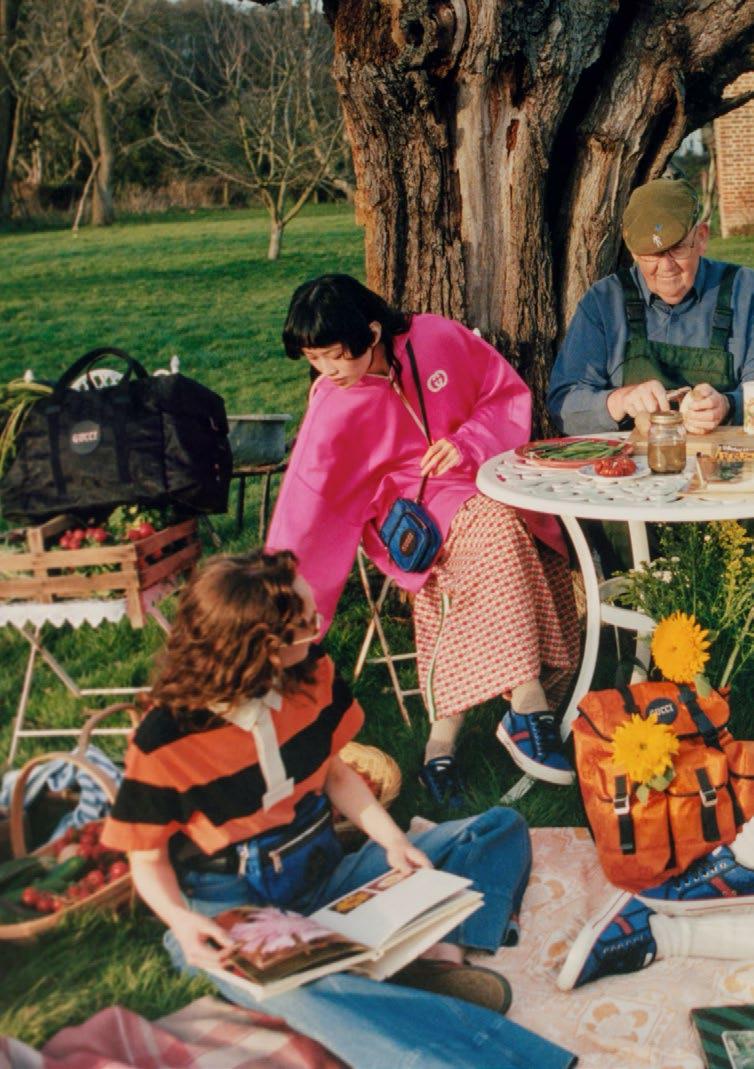

2024
In a not-so-far off future — aka tomorrow — sustainability might come knocking on our back door.
Gardencore is a direct result of our desire to connect to nature during the pandemic. Fashionable enough for GANNI and Levi’s , Gucci also got in on the action, teaming up with gardener Gerald Stratford and cult brand Niwaki to bring streetwear to suburbia.
2027
Olderbrother celebrates natural materials and engaging with nature. From a name that guides you on the path forward to its use of plantbased dyes from wine, oak trees and iron oxide, the brand is chasing down its sustainable vision — while its storytelling speaks of a future where nature is thriving.
2035
Really getting into nature, Vollebak dropped a giant wardrobe of free clothes in the New Mexico desert. Not only gamifying its brand activations, the clothes themselves were cuttingedge — solar powered and designed to withstand -100°C, they’d be good day or night on the sand.

Likewise, Earth Studies are doing all they can to empower us to be part of sustainable systems. Rationalising that “clothing exists between our bodies and the environment” it takes inspiration from the places we inhabit to reveal the beauty of Earth.

2049
Retail spaces aren’t safe either. Rave architecture collective Temporary Pleasures designed the Dekmantel x Salomon space at VooStore, using reused 4x4 roof racks and temporary connections to visualise a space that feels like a moment in the future.
The future's right.
“While we pile up mountains of waste, those made o f ice melt away ”
Gina GRNW ’s collection takes a zerowaste approach, upcycling discarded ropes from a climbing club in Zurich to make garments that honour her pledge to base her design practice on industrial waste.


2073
Knitwear is as much for our present as our past, and Faye Simister’s creations bend reality between the digital and the earthly. We'll see merino ready for the multiverse.
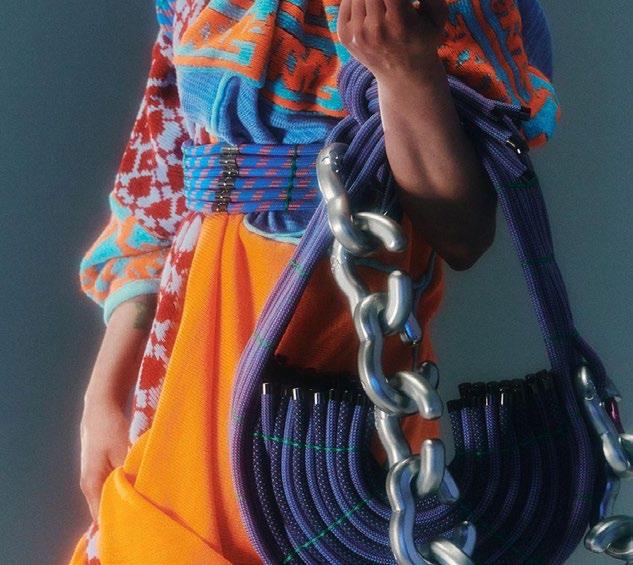
2088
As temperatures rise, it’ll pay to know how much sun you’re soaking up. Panorama Fabric and OBS’ SUNKOLOR Concept Suit does just that. Part second-skin, part thermometer, it changes colour depending on the amount of UV it absorbs, making you more aware of your health (and reminding you to stick to the midday shade).




2100
And perhaps we will reach a utopia where clothing not just supports nature, but nature supports our clothing. Normal Phenomena of Life is a brand where the living world shapes design, expressing its beauty in functional forms. A story which envisions a new ecosystem of biobased production.
To be future ready, every brand needs to understand the bigger picture for customers. It may not be obvious, but this connection to the outside world will impact their relationship with your offer. Are there ways that you can reframe what you do, or tweak the customer journey to create a meaningful response to the issues impacting us all?
→ Take five minutes to write an elevator pitch for why your brand or product has meaning this week.
As customers want to move away from the generic fashion trend churn, which part of your brand storytelling or product is connecting to your customers and their identities, rather than just the broad stroke seasonal themes?
→ Review your last social posts or brand comms – what stands out as the main story?
Business models and consumer habits are evolving. Are you stuck in a rut, or challenging the systems that aren’t working? Take time out from your treadmill to imagine new ways of doing and get ahead of the curve. Even if you can’t make these ideas a reality, radical thinking can inspire smaller changes that shake a brand up.
→ Create a ‘rip it up and start again social’ with your team, bring the Post-its, and see what nooks and crannies of your processes could have a rethink.
Questions from the Land of Plenty studio to help shift your thinking →→→


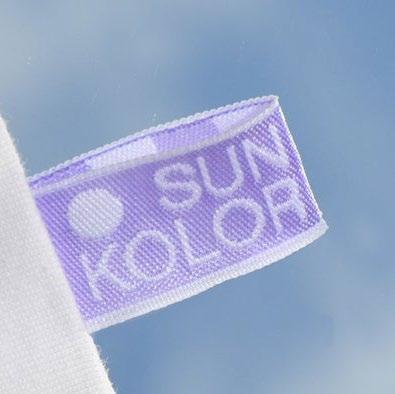
gains
Small steps lead to big places. It's the 1%er mindset.
We’ve
selected the brands that are already chipping away to create the
change we want to see, making progress in an industry that has its challenges. A 360° view, including packaging, PR and process, to shine a light on the details and actions we can adopt with progressive practice in mind.
Small shifts towards being a better brand. It’s the marginal gains philosophy.

Sharing brands and ideas to inspire ways of 'doing' rather than just 'saying'. Being a 1%er is about taking small steps towards being better, not making huge claims of being perfect.
Don’t let a plastic button fool you, they are often a barrier in the upcycling process. It’s why Bethany Williams’ last collection did away with them, replacing them with easily removable eco-finished metal ones, minimising impact and friction.
In the UK, a 2019 YouGov survey revealed that 82% of shoppers would pay more for a grocery shop if it did not include single-use plastics. It’s fair to say that Sway’s seaweed-based, home-compostable replacement might be onto something.
It always looks better online. At least that’s what 41% of Gen Z say, citing their struggle to visualise whether an item would look right when returning their latest drop to the Post Office.
YOUR 1% SHIFT:
What barriers to circularity could you creatively circumnavigate?


YOUR 1% SHIFT:
Are there ways your business could use plastic alternatives to relinquish your consumer’s guilt?

YOUR 1% SHIFT:
How can your brand communications help people better understand what they’re buying?

The world is stuck in a Make-Use-Waste cycle, with people simply discarding clothes that don’t work for them. SOJO is a simple service that breaks the mould, making repairs mainstream. More Make-UseRemake-Reuse if you catch its drift.
Nike Teen is a new space that celebrates and supports young people, neoterically sharing information on body image and menstruation that invites youngsters to ‘normalise looking out for yourself.’
An attachable, running shoe outsole that naturally plants seeds from its bristles as you motor along. Naturally-made for the benefit of nature itself, keep an eye out for Rewild the Run on the streets.
YOUR 1% SHIFT:
Without creating more, how can your brand offer a service that allows people to enjoy the clothes they already have?

YOUR 1% SHIFT:
How are you meeting consumers where they are, speaking their language and leading by example by being transparent and caring?

YOUR 1% SHIFT:
How could your products directly contribute to biodiversity?

Created from the elements, for the elements, Unless’ plant-based streetwear will even return to those elements when it’s done.
Generative, degenerative and regenerative — and it looks great.
YOUR 1% SHIFT:
What materials or processes could you afford to cut from your product or brand?

Jillian Maddocks’ quirky personality and barriers faced as a neurodivergent and chronically ill person inspired an ethically and socially conscious collection that “feels like a hug from the creative, nurturing, unconditionally loving grandma we all wish we had.”
Consumers are overwhelmed by the climate problem. Yet often undereducated on what impact they’re actually having. ThredUP’s fashion calculator makes things more transparent, helping shoppers understand what’s good, what’s bad, what’s real, what’s greenwashing.
YOUR 1% SHIFT:
How are your collections inclusive to nuanced needs and acknowledging disability?


YOUR 1% SHIFT:
What practical tools and ideas can you share with customers to help them lessen their impact on the planet?

Channelling the combined power of circularity and inclusion into the United Repair Centre London, Patagonia is aiming to train marginalised people in high-quality clothing repairs — and fix up 30,000 items a year by 2025.
In what the brand claims is an industry-first, sustainable fashion label Asket will soon begin issuing an emissions receipt alongside its standard monetary receipts.
As a small brand, RAD Clothing produces its shoes in very limited runs, only ordering as many as it thinks it can sell. Rating an empty stockroom over overflowing landfill.
YOUR 1% SHIFT:
Could you get ahead faster by partnering with businesses who share your vision?

YOUR 1% SHIFT:
What tangible touchpoints can you rethink to provide added value to consumers?

YOUR 1% SHIFT:
Could you adjust your KPIs to better align with your mission or ethos?


We see the finished garment on the rack. We don’t see the tonnes of material left behind — the reams of fabric sitting unloved and wasted on the cutting room floor. Thankfully, imaginative brands and designers are finding ways to bring it back into the fashion fold, and elevate it to whole new heights.
Take CSM graduate Eden Tan’s ‘On Borrowed Fabric’ collection for example.
“Since I started creating this collection I aimed to make a line that could be turned into a new one. That was my real motivation, more than the fact that it was beautiful”
“What I want to do is make a collection that doesn’t remove any fabric from the roll. I want to make a collection of clothes that could be as easily reprocessed into new garments as if the fabric had never passed through my hands”
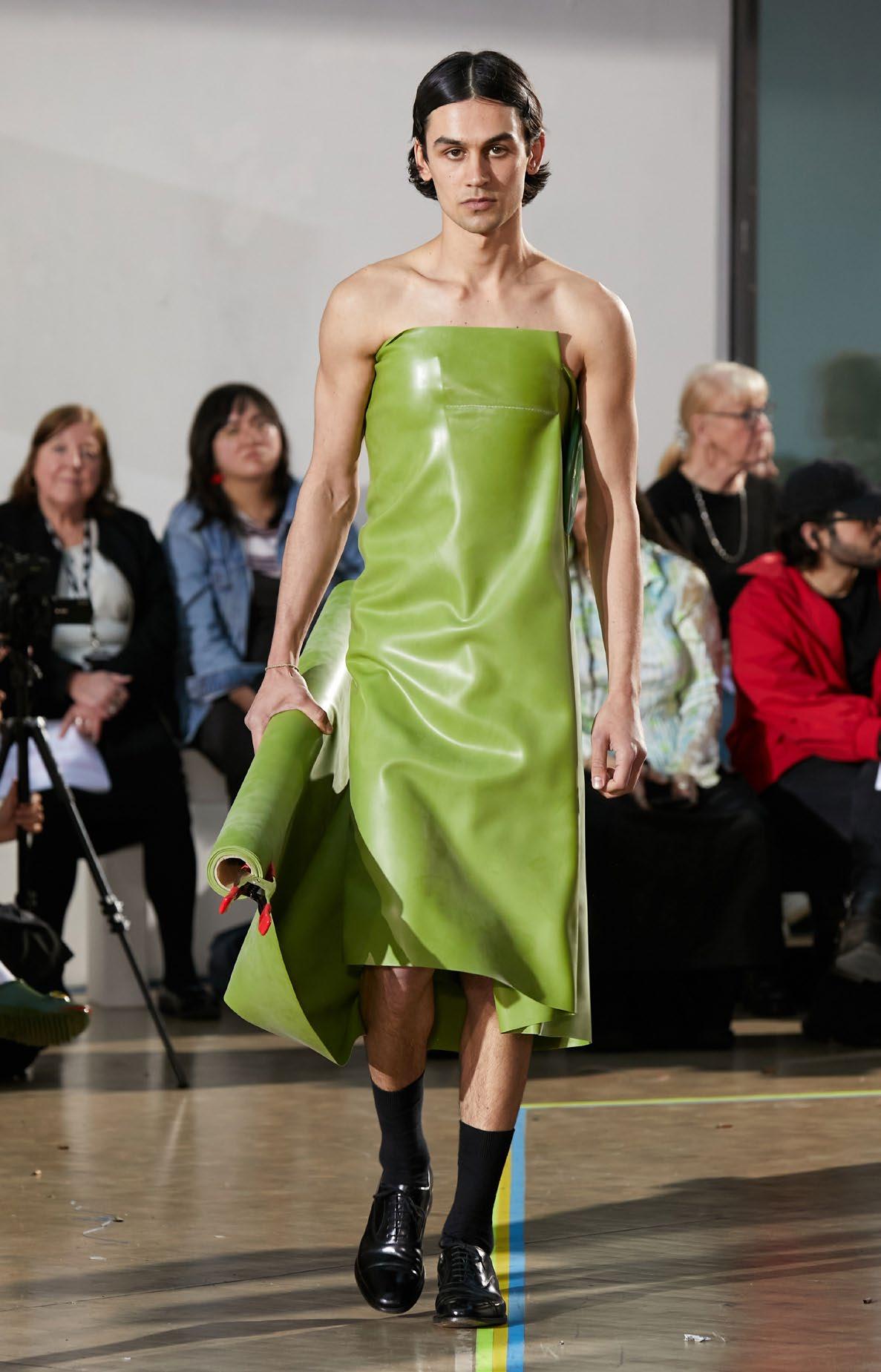
02
Readymade Textiles embodies the same sentiment through its mantra “NOTHING NEW, NOTHING WASTED”. It curates, catalogues and trades a selection of salvaged materials directly from producers — bringing high-end fabrics back into circulation for smaller design teams, and celebrating designs that were made years ago.
Its social channels also further educate its community about textile history and practice, creating content which reinstates its relevance in today’s fashion climate.

Taking a tongue-in-cheek approach, viral designer Nicole McLaughlin is arguably the queen of upcycling. And whether she’s turning Haribo packets into harem pants or croissants into c-cups she takes resourcefulness up a notch. Her collab with Hoka, saw her upgrade its iconic MAFATE THREE2 runner using only end-of-roll material. The result was an 82% recycled product that was even more waterproof and handily stocked five utility pockets. Who needs a bag?



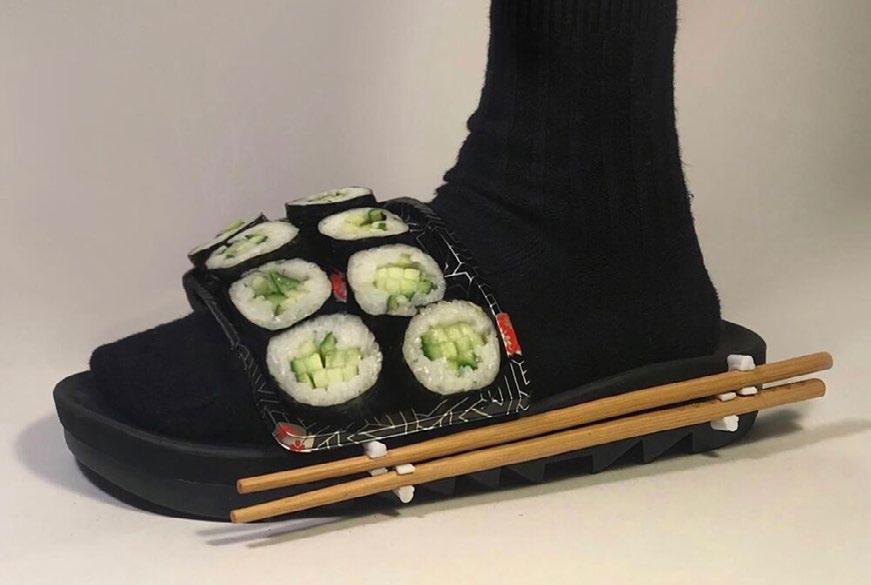
Two Lives by name, Two Lives by nature, Two Lives (you get the point) isn’t one to let things die. Acknowledging every second the equivalent of one garbage truck of textiles is landfilled or burned globally, they give all manner of material a second life — Whether it's turning old Audi billboards into robust tote bags, transforming T-Mobile's leftover uniforms into corporate merchandise or repurposing Lois jeans' unsold inventory into new products.
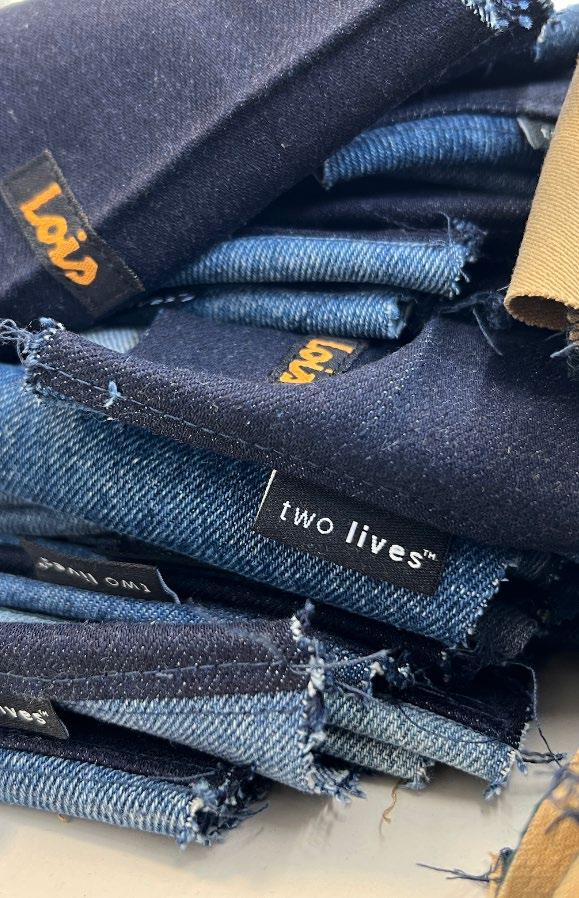
But arguably no-one’s raising the stakes quite as high as Benim Denim. The Swedish ready-to-wear denim brand, founded in December 2022 has just shut up shop. And it doesn’t even mind. The brand was purposefully conceived to revive one sole 170-metre roll of deadstock fabric, and has closed its doors for good now that the waste material has been used up.

That’s all well and good. But how might we go about creating less waste in the first place?
For its Spring Summer 24 show at New York Fashion Week, Eckhaus Latta teamed up with fashion tech company Unspun to develop a radical selection of zero-waste 3D woven garments. The collection — including a pair of twine tree-trunk-esque trousers, elbowhigh jeans and a vest that’d make a galaxy look dim — was all printed with Unspun’s ‘Vega’ technology in mere minutes. No waste. Only runway hits.


It’s easy to discard ideas and processes that don’t create a big bang, or shift the dial too much. But are there simple shifts – in business practice, that could add up to make a difference. What have you overlooked?
→ Write down all parts of your business – it can help to think about who’s in your team and who you work with (don’t forget your accountants!) – and start a conversation about each part with someone in the know; maybe they have ideas they want to get off the ground.
So much of sustainability focus is on clothes production in the fashion world. But are there corners of your business – whether marketing, packaging, distribution or store design – that could be better for people and planet? How about rethinking your labelling approach, or looking at your PR strategy to minimise waste when launching a new collection.
→ Get down to your stockroom or shop floor and pick one product. Capture its lifecycle and touchpoints – where might you shift the decision making or story?
Feeling overwhelmed with the ways in which you could be better? Or nervous about how to talk about what you're doing when there's more to be done? How about celebrating one difference you're making now with your team, or even your customers, and setting just one goal for the next quarter that could make a difference. That's what marginal gains is all about.
→ Fit something into your weekly or monthly meetings to discuss this - everyone on your team will have insight on the small things they're doing to make change.
Questions from the Land of Plenty studio to help shift your thinking →→→
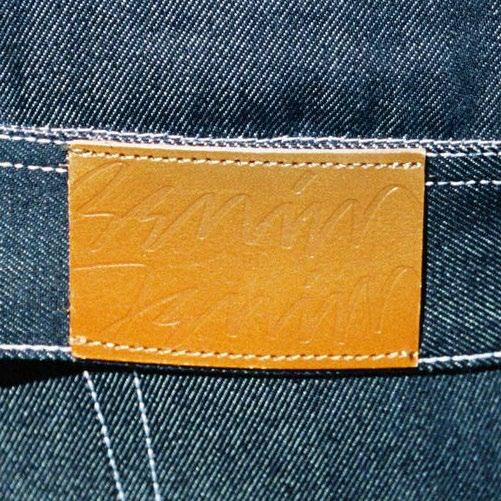

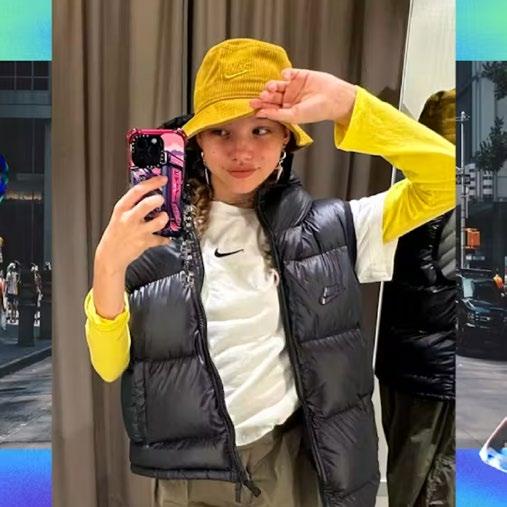
Life’s
too short to let the darkness define us.
We’re sharing ideas that put a smile on our face, give us hope and encourage us to continue to collaborate with the fashion innovators. Thinking about the bigger picture and our relationship with the heady world of fashion, as well as finding ways to connect with customers in ways that break through the bullsh*t.


As much as individual decisions add up, consumers can’t take on the whole fashion challenge alone — especially during a cost-of-living crisis. But does that do much to remove the guilt they feel? Does it heck.
Throw in climate change, and that guilt explodes into all manner of emotion. According to 33 Zero: 38% 37% 36% 7% Anxiety’s at Fear Frustration
And contentment clocks in at a paltry



But. BUT. Fashion can still be fun. Fashion can deliver joy.
And the more brands can educate, support and celebrate planet-positive decisions, the brighter things look for their customers. Storytelling, spaces, comms and touchpoints can all breadcrumb people towards choices that are right for them. Whether they’re ditching dodgy packaging, connecting with like-minded people, or sharing wisdom on how fashion works.
There’s hope ahead, and while 33 Zero might have it at 17%, we think there are plenty of silver linings we can embrace to turn the guilty into the guilt-free.
“We need solutions that don’t just tell people to stop consuming, but give them alternative methods to consume fashion in a more sustainable way.”
— LUCY HALL, LOANHOOD

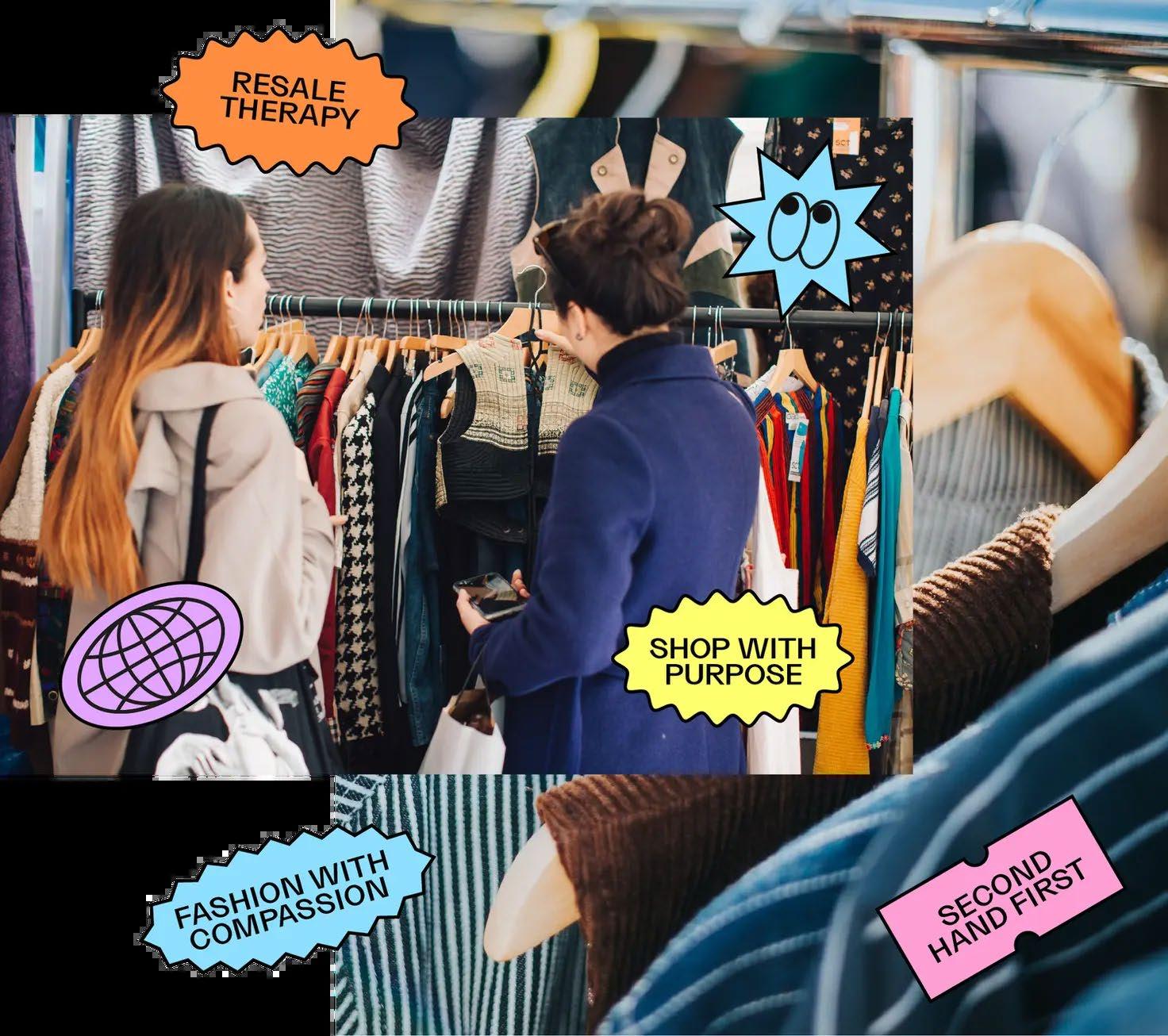
Nothing gets people talking like fashion. But imagine if we could level up that dialogue and connection into positive community and planetary habits.
In our Hospitality Shift, we looked at the idea of Community Biomes, where brands amplified their activity to create a longterm impact on their local ecosystems.
Fashion might be a different kettle of fish — with most brands operating globally online rather than at one or two destinations — but it can still foster a sense of connection and facilitate constructive action. All it takes is signing off and meeting up in real life.
Networks such as Loanhood and CharitySuper.Mkt demonstrate this wonderfully. Creating a sense of community through the second-hand market, both allow people to exchange ideas as well as clothes. Solidarity and conversation around one shared interest, without a screen in sight.
No fashion house builds rapport like the sports brands.
Rapha, as expected, leads the way. Made up of Chapters based out of their Clubhouses around the world, the Rapha Cycling Club is an active (literally) community of members who bond over their love of riding, Lycra and Sundays away from the family.
There are plenty of brands in their slipstream though.
Lululemon launched Together We Move, a commitment to make 2024 the best year yet — with the help of your community by your side. On Running went after AI to encourage runners to set off together. Satisfy Running invited meaningful connections through meaningful content, curating a retro-inspired magazine that chronicles its community’s journeys.
These aren’t major overhauls. But they tell a story and create a world people want to be part of, and are sprinting towards in their thousands.

We know what you’re thinking. Sport, community… the two go hand in hand. So how might these initiatives affect, let’s say, a RTW brand?
Well, let’s look at luxury fashion retailer, Telfar. It’s using the power of the collective to tactically encourage customers to club together and get the cheapest price on its latest drops. And it’s doing it in just four steps:



A brand that’s already been lauded for celebrating Black culture and community, it’s now being labelled as a pioneer making luxury more accessible to a wider audience.
This spirit has even expanded to a 24hr live network — Teflar TV. In collaboration with the Ummah Chroma Collective (“the community of colour”) the channel takes shape live, with user-generated content creating the daily listing.
This crowd-sourced approach puts its customer, and its community at the centre of what it does. Yes it’s already a highly sought after brand, but that doesn’t dismiss the fact they’re challenging the fashion system so it works for their customer base.
It all begs the question: what community are you seeking? And how can you utilise your brand to not just seek their attention, but hold it?

Tom Heyes is the Commercial and Trade Director at Goodhood, having worked with fashion giants like Dover St Market and Net-A-Porter. In the run-up to the new store opening and the launch of Goodhood 3.0, we sat down to chat about brand building with a commercial hat on, and how the stories and ideas we share with customers shape their relationship with us and what they buy.

LOP:HeyTom!Thanksforsittingdown withustoexploresomeofthebigshifts inFashionandLifestyleandLeisure. We’vebeenreallyinterestedintheidea ofbuildingcommunitythroughthese typesofindustries.Goodhood’ssocial say“Goodhood–Community–For thepeople,bythepeople”.Whatdoes communitymeantoyouinyourbusiness –notonlyyourcustomersbutalsoin howyouoperate?
TH: The mindset of major fashion e-com players is to be everything to everyone. Their viewpoint becomes quite diluted; they’re not standing behind anything. At Goodhood our community is our customer base – like-minded individuals who are into the same stuff that we’re into music, design, art, literature, food… We’re small, we don’t have huge overheads and so we don’t have a need to be everything to everyone. We can just pick and choose the things that are interesting to us.
Personally, I don’t feel like fashion is very interesting at the moment. We are in a saturated marketplace where there’s a huge cultural shift away from these massive online retailers like Matches, FARFETCH, Net-A-Porter and Mr. Porter, who are creaking now because people don’t want to see 200 pairs of
black trousers or 300 knitwear brands. Customers want to hear that “we spent the time to find these for you guys, and we think they’re good”. Because of this, our communities, our customers, have a similar taste to us, and so together we can explore ideas that don’t necessarily come with lots of money attached alongside that more commercial relationship.
Like last night we did a listening party for Mount Kimbie, as we’ve recently started working with Warp Records doing album launches and listening parties. At Goodhood, it’s not always streetwear bros coming in and having a free beer, we can have of a bit more fun with engaging with our community. We can talk about what’s good, do film screenings, talks and workshops, or we can host an interview with Glenn Kitson or a Weird Walk in the countryside curated by the guys that love big stones.
If you’ve got engaged customers who look to you for direction and find you interesting you can go on a bit of a voyage of discovery together, it has integrity. You’ve got to keep your community happy and fed with things that are interesting. Not just more clothes from the same old brands. It’s a symbiotic relationship. We can’t exist without them.



LOP:Yes,itseemsyourcommunity, yourfollowingatGoodhood,isina circularrelationshipwithyou,defining yourbrand.We’dbeinterestedtoknow, howdoesbuildingthesecommunity relationshipsplayoutwithacommercial lens?
TH: Life used to be simpler. We would get a sneaker launch and put an email together about what the sneaker is and the history behind it and make huge amounts of money off those kinds of comms –really straightforward. But the world has changed. Now it’s about taking what we think is good to the customer in an authentic, legitimate way, and then looking to convert sales from those emails or social posts. It’s about balancing the commercial with the cultural elements, things that are interesting and that we as a brand stand behind – the non-transactional sort of relationship with customers, where we are trying to make a connection rather than sell stuff.
If you put a post on the Instagram grid, which says ‘come and buy these jumpers’ you get very little interaction. No one finds that interesting. What IS interesting is when you post something about rave flyers or old Stüssy adverts or the style legacy of someone cool, suddenly customers are engaged, you’re telling stories, giving them
ideas. It helps our customers believe in us and trust us – they know they can come into our store and find something that they genuinely like and will want to buy, because we’ve had a broader conversation with them.
We send a weekly cultural email out – a Sunday Supplement mailer which shares ideas like this – this has an incredibly high open rate, much higher than anywhere else that I’ve worked before.
Ultimately, you have to engage with the customers beyond the product – if they want to come and buy something, they know they can come to the store or the website. But it’s more than just directing them to a sale. We can’t tell them what to buy, but we can let them know what we think is good or surprising us at the moment and hope they agree.
LOP: We’vebeenexcitedtohear aboutthenewGoodhoodspaceonthe horizon.Howisthismindsetofbuilding relationshipstranslatingintothinking aboutyournewstore?
TH: We’ve got a real opportunity with our new space. Coming from Dover Street Market, my philosophy has been that you give your key brands a space to play around with, give them some freedom to test things out, and explore what they can

offer to our community. Having more space equals more freedom and potential to explore ideas and build relationships. And so firstly, we want to have fun with our brands and work with them in a more engaging way. We want to be a complete lifestyle store, like the ones you get in Japan – like Tokyo Hands – where they’re showcasing what they believe is the best in every category, not just fashion or product. We already work with some amazing partners who we believe are the best at what they do. Like Strange Paradise Records, who have really quickly become an iconic East London record store, and who were thrilled to be on board in joining
us in our new space. Artwords bookshop too.
We’ll be able to showcase what we think is the best in interior design, or we can give away a huge space to someone new… there’s a whole world of opportunities when everything can be modular in both space and mindset, things can come and go.
We’ll have a whole terrace at the back, so if someone wants to put a load of skate ramps in there, if someone wants to put a music stage out there, if someone just wants to do some food… it gives us more opportunities to do things in a more meaningful way. We won’t just showcase

these ideas digitally through content, we’ll be able to bring them to life.
It won’t just be a shop, it will be a hub where you can come down and get a drink and some food, hang out with friends and maybe discover something new. This idea of inviting people to hang out with us is really exciting to me.
That’s the main reason why we’re moving to the new store but secondly, I do think the world is really bored of online retail. It’s all about how much money you can spend on Google, on ads, undercutting people, SEO, PPC, conversion and tactics, how to give people quicker checkout or 10% if you sign up to our newsletter, there’s just little discounts everywhere. It’s a whole different mindset.
I’m sure it will always continue to exist and people will do it well and they’ll be the ones that survive this cultural shift. But, at Goodhood, we want to really focus on physical retail and for the website to be supplementary to the physical business. Because personally, we believe in our community actually coming down and living the physical retail experience. That’s how we see the future; to be in a new area which is a much more vibrant, positive area of town. We want to make it easy for our customers to come in and visit, to join us and have that relationship.
LOP:Sustainabilityisalsoreallyatthe forewhenthinkingaboutfashionand retail–we’vebeendiggingintohow peoplearereallyrespondingtoitintheir context.Howareyouthinkingaboutitat Goodhood?
TH: Everyone knows that overconsumption is a huge problem. We certainly don’t make any bold claims about ourselves. I think that we are seeing a cultural shift in shoppers: people are buying less now in general, especially younger customers.
They are looking more at influencers, looking at what certain people they identify with are wearing and are in general more specific about the brands that they want to buy into. It’s more about a uniform or an identity. They’re following a set of style rules rather than just buying what looks good on a hanger or a scroll. Also, it’s really important to this customer that there’s a resale value to what they buy. There used to be a stigma attached to second-hand clothes 20, 30 years ago. But now it’s just normal – and the whole world of second hand is really exciting.
So we’re seeing a whole shift away from buying twenty things from Primark, ASOS or Shein. These businesses are all posting massive declines and I don’t necessarily think it’s just down the to cost of living

crisis, I think that it can be attributed to people being happier to spend more and buy less.
At Goodhood, we aren’t sitting on mountains of stock, we’re very frugal with discounting. I’d prefer to do none of it – in fact in the long term the plan is to cut right back on all of that, disband the traditional season selling cycles which are becoming shorter and less relevant. We don’t really engage in the race to the bottom with prices, nor do we encourage overconsumption. We have to also trust that the brands we choose to work with are doing their due diligence and not being unethical – on that we really do rely on trust. We carry brands like Story Mfg, for example, who create pieces from natural dyes, doing fashion in a slow way, and are also working with Gomi who are recycling our carrier bags into speakers and power banks with a circular mindset.
So there are practical choices we’re making with our buying and how we work with the seasonal model, but also, it’s about framing the decision around why we would buy something in a way that’s less about buying more, and more about buying well – or at least buying something that means something to you.
andLifestyle,andthat’satthecoreof Goodhood’sphilosophytoo.Howdo youunderstandtheideaofLifestyle intoday’scontext–thingschangeso quickly.
TH: Goodhood’s perception of lifestyle has never really changed. The makeup of our business has always been half lifestyle with interior design, music, books, cosmetics, ceramics – trying to tap into what people find interesting, be a voyage of discovery and less so just another clothing retailer.
I do think that’s part of the reason why we’re standing the test of time versus some of our contemporaries who are similar in size to us – albeit in different cities – who have recently ceased trading. It’s just not possible for them anymore as a clothing retailer, up against companies that go into sale with 24,000 SKUs all at 50% off – you just can’t compete with that. Goodhood has weathered the storm because it’s always been about a lifestyle – yes it’s about what’s fashionable, but it’s looking at this from a whole life perspective, not just the clothes.
LOP: WeframewhatwedoatLand ofPlentythroughthelensofLeisure
LOP:Finally,arethereanyfashion brandsorfashionrelatedthingsthat arehappeningoutthereonyourradar thatyou’rereallyexcitedby,thatyou
wanttobringintoGoodhood,orthatyou arepersonallywearingorbuying?
TH: I do find, after working in this industry for such a long time, that a lot of fashion or streetwear brands are a bit boring; there are so many of them out there now and lots of stuff looks the same.
I like the functionality of a lot of Japanese
brands – hiking and outerwear brands that are built for functionality. The design is very considered, a lot of the best lifestyle stuff is coming from there. That useful, practical stuff will never go out of fashion,
I know I’ll buy it and have it for the rest of my life – I guess that’s how I think about sustainable fashion.
The last five years have also been
dominated by brands doing collabs. Especially ones like Stüssy, Supreme and Palace who are finding these cultural touch points, these meeting of minds with music or films or other brands. I do like the idea of wearing your identity on your clothing, so I’m always excited to see what those brands are doing and who they’re going to collaborate with next.
I think clothing for clothing’s sake now is going to be difficult. It’s a difficult sell. There has to be a meaning to it.

Everyone thought the pandemic had killed off the in-store experience. But they’d only killed a version of it. Now it’s back, and the community is inspiring it like never before.
Just look at Footlocker. A high street staple since forever, it’s now branching out into the sticks — prioritising smaller spaces in less urban locations. Here, it can create a more bespoke experience, planning events and takeovers for locals that connect to the things they value over cookie-cutter mall offerings.


“Consumers are frequently shopping online due to convenience, but enjoy the social aspects of in-store that online will never be able to recreate.”

Obviously there were a few that were ahead of the global lockdown. But their concepts feel more relevant now, than ever. Arket opened in London in 2017 as a ‘modern day market’ that supplements its own core collections with curated and complimentary brands. There was even a cafe that tempted people to linger around for longer than they expected.
Now, many brands are shifting from connecting products to connecting experiences in their stores.
Last year, Aries opened its new flagship store in London. Positioned as a ‘changeable’ concept and art space, which can host talks, exhibitions, collaborative projects and book launches.


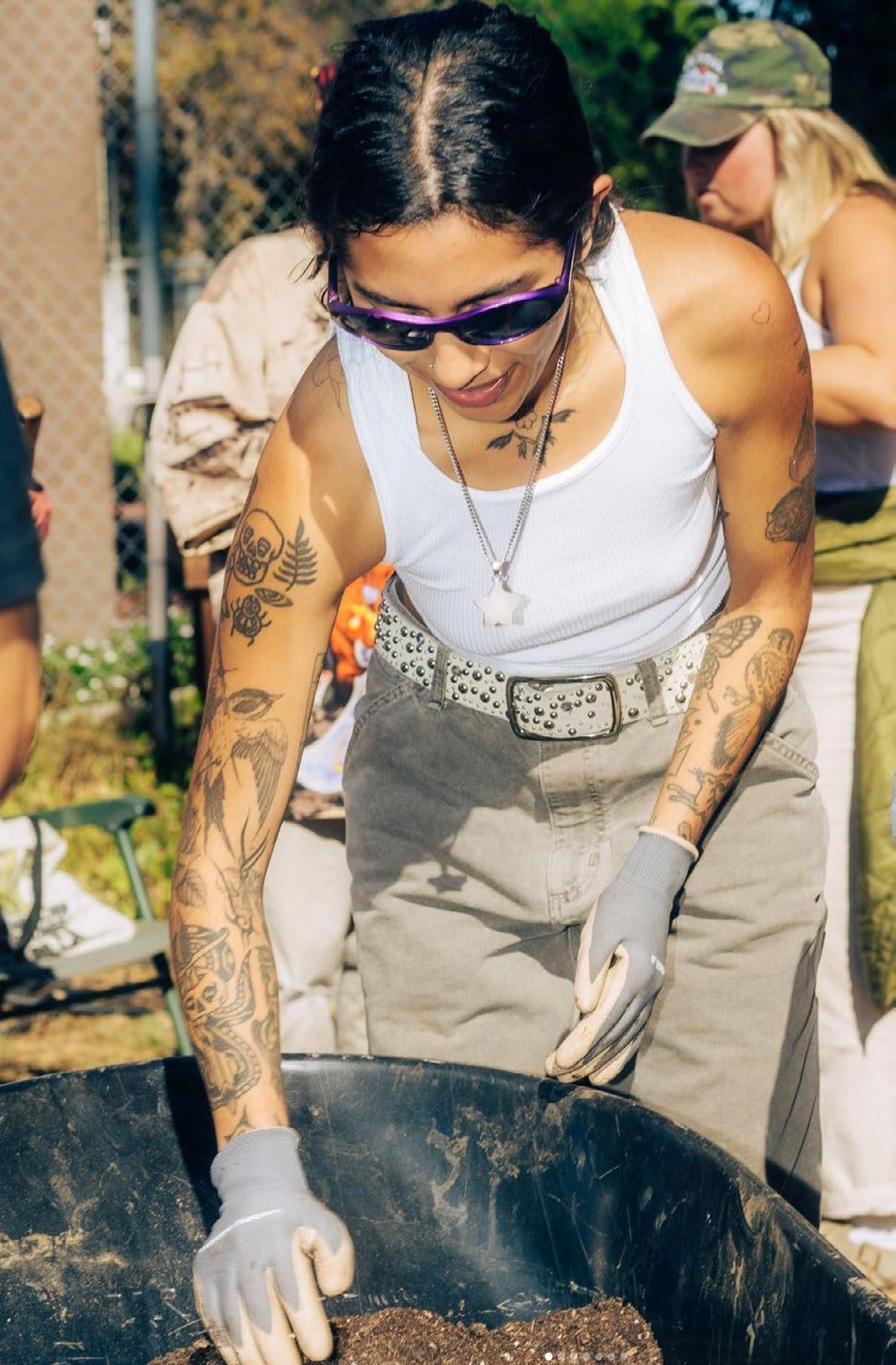

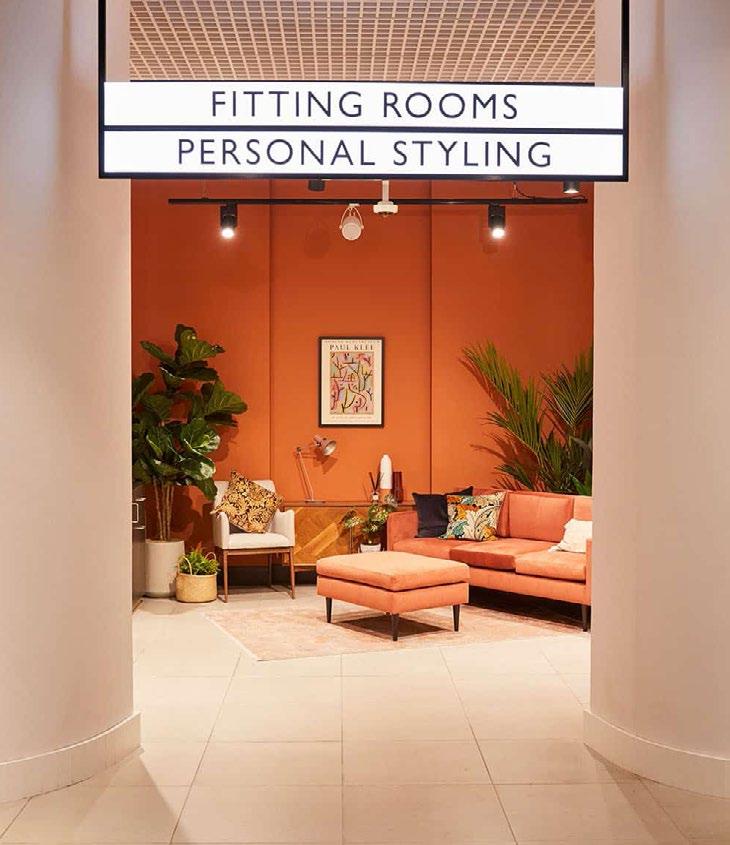
Similarly Usal in LA, uses the lenses of ‘Escape and Learn’ to bring together collaborators to offer experiences for their shoppers — from wild clay foraging to hosting Gorp Girls Climb nights.
Even the nation’s sweetheart, John Lewis has been exploring this change in tact with The Yard Creative.
“Customer-centricity, data, adaptability and iterative processes were all at the heart of this new thinking. So too was our design principle of ‘Never Accept the Expected.’” Rewarding digital-age customers for their physical time in store, the partnership created entertainment and theatricality in a format which flexed to changing needs and trends. Partners have been retrained as experiential retailers, there’s a calendar of events and store activations, even the seasonal displays at the entrance help tell the right story.
“Although mass reach can be a massive pro through algorithm, our biggest con is that our community who follow because they love the brand are often excluded from seeing our latest content.”
Much like the hospitality brands in our previous Shift report, fashion spaces are recognising the importance of the third space, and hosting their audience.
Pirate Studios epitomise the approach. Housing a third space destination, it gives music lovers a place to socialise, create and record. But more than that, it gives brands space to insert themselves into the experience — whether that’s through content sponsorships or by strategically supporting niche, emerging talent in music, dance and podcasting, and going after their fans.
There’s clearly life in the old store yet, and it's fascinating to watch its evolution as brands look to connect experiences in their stores in the same way they’ve been successfully connecting their products online.
The in-store experience isn’t going anywhere. But is there enough value for your brand to go after it?
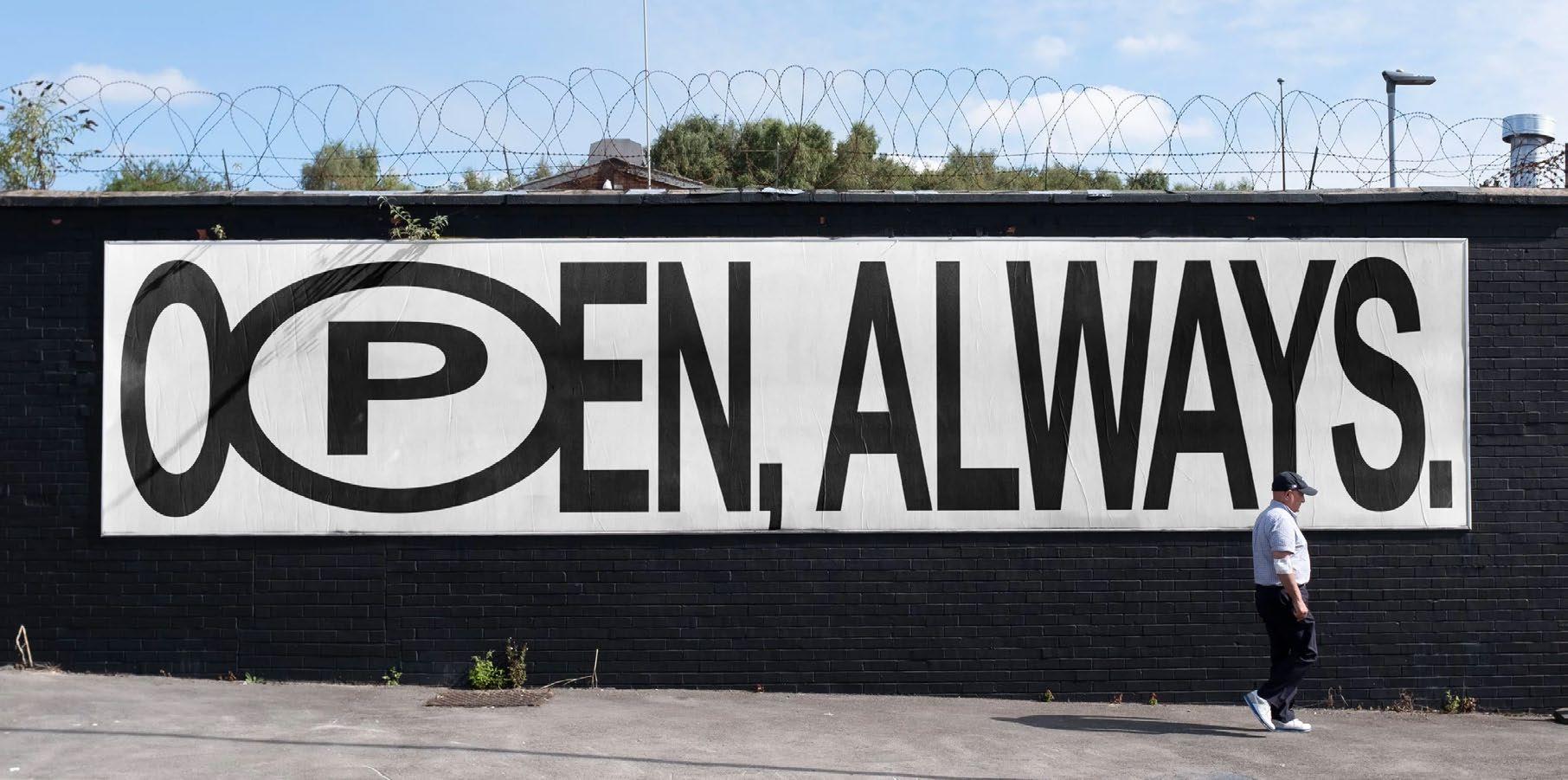


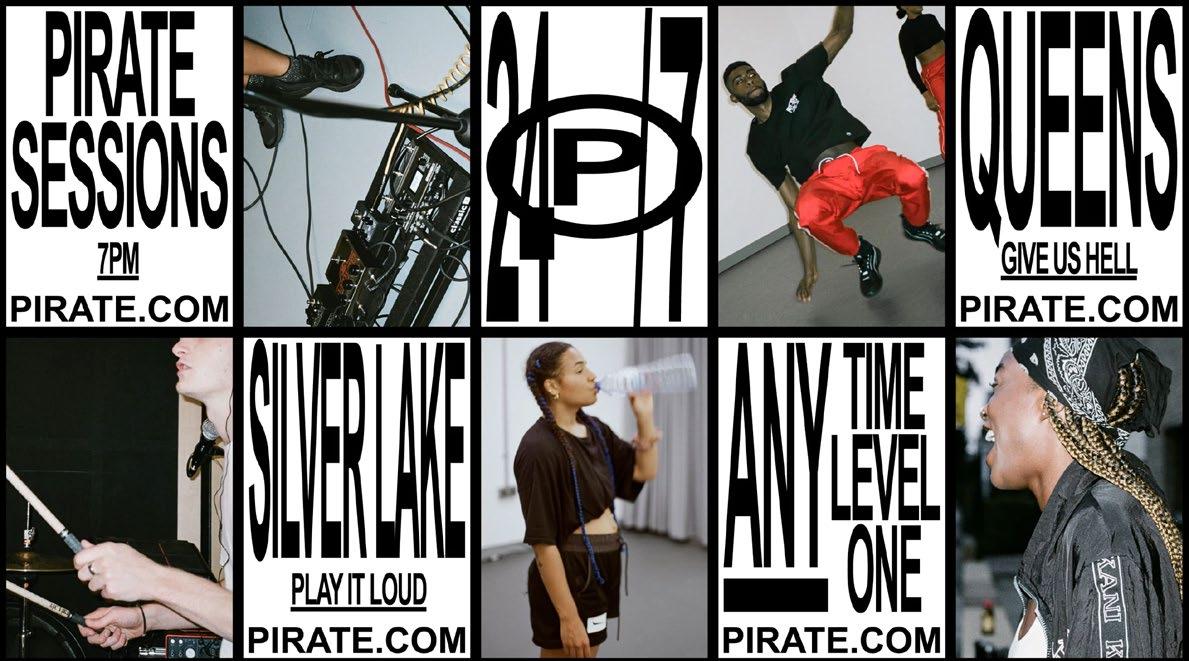
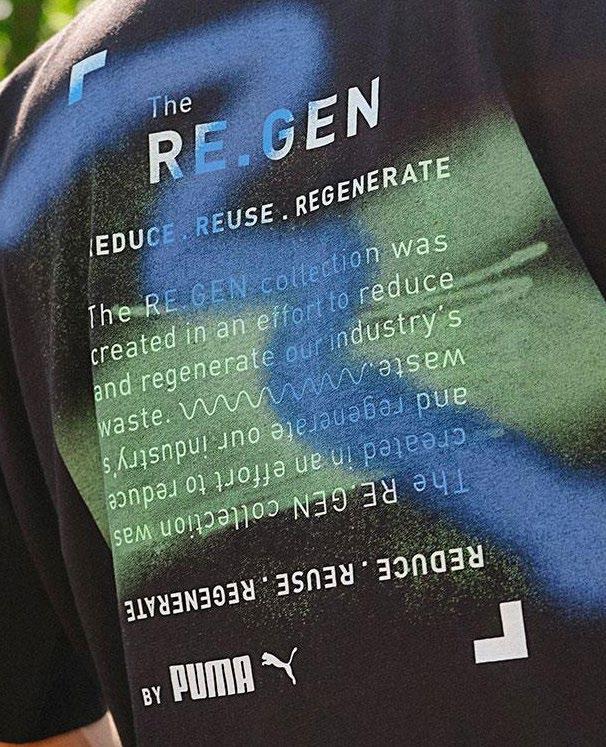
Ok, so we’ve talked about real connections. We’ve covered real stores. Now it’s time for some real talk. Because whilst the outlook can’t always be sunny, there’s so much joy to be found in solidarity and transparency, in honesty and humour.
Now more than ever, brands need to take ownership of their own narrative. It’s becoming increasingly evident that how and where things are said is just as important as what’s being said, and addressing all aspects of your voice will only pay dividends down the line.
Puma recently launched its own sustainability podcast, Re:gen Reports, with the aim of demystifying sustainability and empowering audiences to make changes toward becoming part of the solution.
Kerstin Neuber, Head of Communications told The Drum. “The data has shown us that this is the right medium for our message. According to the 2022 Spotify Culture Next Report, Gen Z podcast listeners in the US increased by 62% between Q1 2022 and the year prior. We’ve taken our 300+ page report and distilled it down into digestible episodes for listeners to access via a medium they’re already engaged in.”
Talking to people where they are is really important. And Puma isn’t the only company bringing its consumers into its storytelling.
Leading textile business Spinnova worked with young people to give them a voice as part of their campaign. Acknowledging that “climate change is the numberone concern among young people. And concurrently, youth is the ideal time to explore identity through clothing — a guilty pleasure for the environmentally conscious set. We wanted to give this generation a way to discuss what keeps them up at night, what brings them hope and how they intend to make a difference.”
The resulting platform was built on a cross-section of youth throughout Helsinki. Spinnova listened to what they believed could be done on a government, corporate and individual level to enact change. And, unsurprisingly, when these

children heard their own thoughts played back to them in their own words, they connected with the campaign.
The brand has a stellar approach to talking about what it does, especially when you think its industry is usually awash with technicalities and jargon. Its clean-cut, beautiful communications offer a range of touchpoints to understand the impact their products can make, and the sheer lineup of their
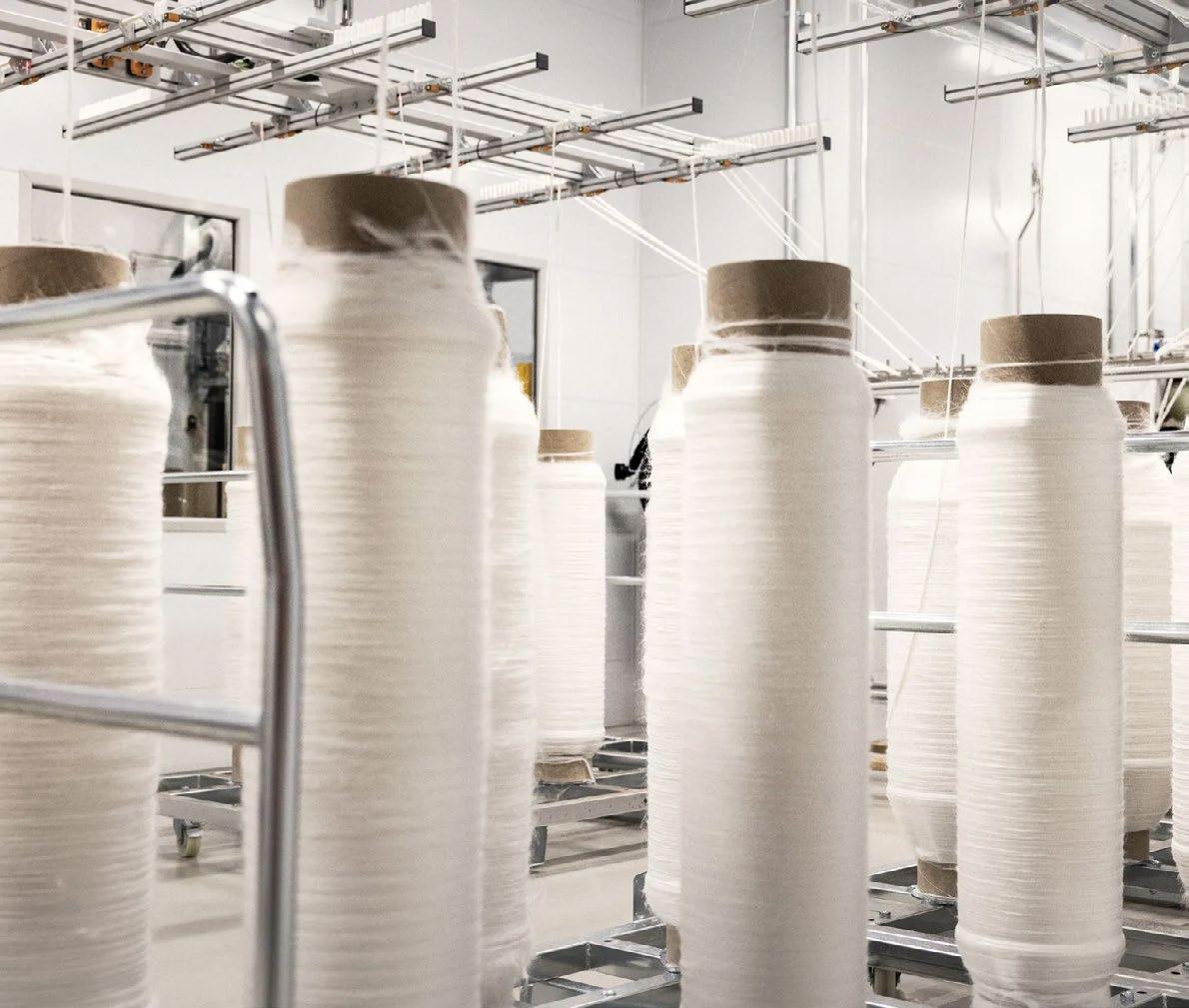
collaborators is a testament to how this has worked.
From a virtual hub that uses film and interactive virtual space, to beautiful macro photography paired with sharp portraiture, Spinnova knows exactly how to spin things the right way.

A decade ago, I was in a fitting room trying on some jeans and my conscience said "you can't buy anything that's not ethical". It was 2013 and I was thinking about sweatshops and workers' wages.
Fast forward a few years, I had moved to Bristol, studied music and set-up a sustainable & ethical fashion boutique in a shipping container. I wanted to make ethical clothing accessible.

Just read Yes Friends' manifesto and you instantly warm to their openness and candour. Down to earth, and on a genuine journey to make a better product, it cuts through by being realistic, relatable and not in the slightest bit righteous. Even the name feels colloquial.
Similarly, but in a very different way, Armed Angels cut through with a no-nonsense Ronseal say-it-like-itis approach. Just one look at their earlier action report and you don’t want to cross it — or disagree with them. Clarity and transparency in this instance translate straight into a compelling case to engage with the brand. The definition of a voice of reason.
A picture speaks 1,000 words, but a clear voice speaks thousands more. How much could your brand unlock with one?

Every brand out there claims to be “going green” or even being “carbon positive”. And their claims are shadowed by the smoke of the burning forest, washed by the rising sea levels and dry out together with the dying soil. To be honest, it all stinks of sustain-abullshit. We know we can’t buy our way out of the climate crisis. We can no longer long for more when what we need is less.
With the focus on in-person retail on the rise, when did you last consider your IRL interactions with customers? Even without a shop floor there are ways to build relationships that go beyond likes and shopping cart clicks, and it doesn’t always have to involve giving away free beer!
→ Get old fashioned and dream up a party invitation that you’d send to your dream customer –what are you inviting them to do, and how would you like them to engage?
One of the biggest problems consumers face is overwhelm from choice and sustainable decision making. How are you bringing transparency and clarity to your brand communications? Is it through copywriting, labelling, or more inventive touch points?
→ Write down your three sustainability selling points. Now, ask a critical friend to visit your store or site – can they see what your vision is or is it hidden in waffley copy or a page on your site no one visits?
At the end of the day, fashion can still be fun. Whether designing for more inclusivity, or using your garments to grow real life connections, could taking time from sales reports to shape storytelling that has substance ensure your brand is remembered for years to come?
→ Think big. Write four imagined news headlines from 2030 that speak to what your brand has achieved. It could be to do with connecting to your customers, or for shifting the dial for the sake of the planet.
Questions from the Land of Plenty studio to help shift your thinking →→→



The nuts and bolts in our engine room
This mission runs through our work as a studio, how we work with our clients and collaborators, and in the projects, brands and ideas we build. But how do we make this work for you?
We help you navigate towards a better brand and business, making incremental and important shifts along the way. Sure, the destination's invariably different, but the journey always starts the same way...
Whether you’re just setting up shop or at a point of realignment, refinement or growth, we can offer an end-to-end service or any one of the following individual components.
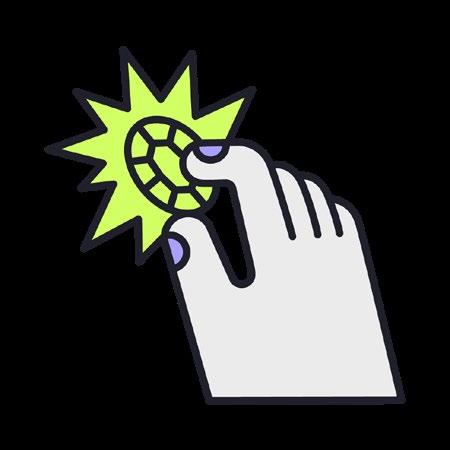
A deep understanding of the job at hand is the bedrock of any worthwhile work – just ask our Head of Research, Liv. Whether you’re looking to widen you r view, seeking greater clarity or honing your brand awareness, we can help you start on the front foot.

The logic that unlocks the magic. Strategic thinking is the key to creating strong brands and effective brand communications, that speak to their intended audience and hit the right note. We’ll help you bring context to the complex and define a clear direction of travel.

From considered brand evolution to comprehensive brand creation, we’re passionate about building DNA-led brands with a unique spirit and voice. We don’t fit square pegs into round holes, instead, we work closely with you to craft a brand around your business vision.

Branding is about reputation and relationship building. Whether working with established brands or those we’ve helped create, bringing them to life across the various physical and digital touchpoints is where our studio’s cross-discipline expertise really comes into play.
We are proud to have partnered with, and continue to support, many brands and organisations across the fashion industry. The research and the work we do is the backbone to such relationships. If the ideas and ethos throughout this report aligns with your own vision, why not DROP
. We'd love to hear from you.






